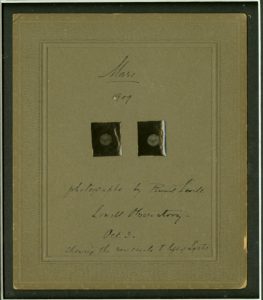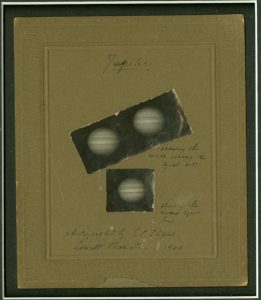
![]() In 1909, the eminent astronomer, Percival Lowell, made this photograph of Mars, in support of his speculation that there were canals on the planet, perhaps remnants of former life. A member of the wealthy Lowell family of Boston,in 1894 Lowell founded the Lowell Observatory in Flagstaff, Arizona. Located nearly 7000 feet above sea level, this was the first observatory to be placed deliberately at a remote, elevated site. In 1930, Pluto was discovered at the Lowell Observatory.
In 1909, the eminent astronomer, Percival Lowell, made this photograph of Mars, in support of his speculation that there were canals on the planet, perhaps remnants of former life. A member of the wealthy Lowell family of Boston,in 1894 Lowell founded the Lowell Observatory in Flagstaff, Arizona. Located nearly 7000 feet above sea level, this was the first observatory to be placed deliberately at a remote, elevated site. In 1930, Pluto was discovered at the Lowell Observatory.

Lowell devoted his career to the study of Mars, publishing three books about the planet, focusing on the canals and the possibility of life. In the 1960s, NASA’s Mariner missions and the Mariner 9 orbiter in 1972 recorded a cratered surface. The canals that Lowell theorized were built by a desperate culture to tap the ice caps for water on a drying planet are today considered to be an optical illusion.

Earl C. Slipher joined the Lowell Observatory staff in 1908, later serving as director, Like Lowell, he specialized in the study of Mars, later published a book of photographs of the planet. The photographs in Middlebury’s collection were most likely acquired by Middlebury Professor Ernest Calvin Bryant, perhaps after a visit to the Lowell Observatory. They were saved from being consigned to oblivion by Frank Winkler, Gamiel Painter Bicentennial Professor Emeritus of Physics.
Scroll down for a video commentary by Frank Winkler on Percival Lowell.